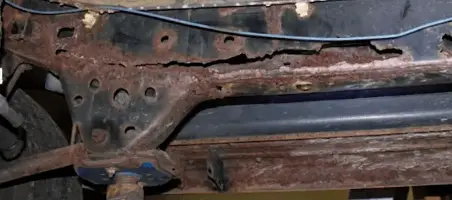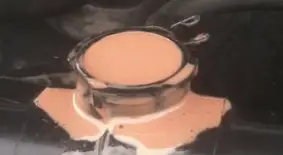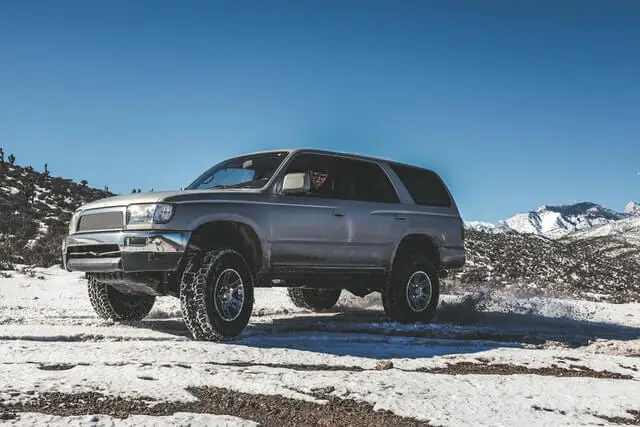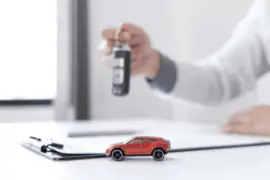Last Updated on January 29, 2024 by Rose Morah
Before buying a 3rd generation 4Runner, there are a few things that you will need to check. Things that could end up saving you lots of money and prevent you from buying someone’s problems.
It is important to note that some of the common issues of 3rd generation 4Runner can be easily fixed. But if you spot them during the inspection, then you will be better placed to negotiate the price.
To help you with the inspection, here is what we are going to discuss:
- What to check underneath the 4Runner.
- What to check in the hood.
- What to check at the back.
- What to check in the interior.
- What to check on your drive test.
NOTE: 3rd generation Toyota 4Runner is from 1996 to 2000.
Related:
Best 3rd Generation 4Runner Interior & Exterior Mods & Accessories.
The Best and Worst Years For Toyota 4Runner (Buyers Guide).
What to check underneath the 3rd generation Toyota 4Runner
Before anything else, the first thing to check is underneath the vehicle.
A lot of time, the vehicle could be looking amazingly good but the underneath says something else.
Check for the following issues underneath the vehicle:
1. Rust
Check if the metal frames have been eaten up by rust and have holes, especially the frames that hold the axle in place.
If you spot rust that could almost be similar to the one on the image below or even close to it, run as first as you can!
This is because the metal frames may end up breaking apart thus costing you lots of money, and in some cases, you may end up just tearing the vehicle apart and selling parts.

NOTE: Rust is one of the main issues that kill these vehicles!
See also:
Best 4Runner Tires For Road Trips, Grip, Fuel Efficiency & Off-Roading.
Buying A Used Jeep Wrangler JK: What To Know & Look Out For.
2. Check for oil leaks and pink color underneath
Oil leaks could be a sign that something in the vehicle is broken and needs repair. Therefore, be sure to check carefully if there are oil leaks underneath.
A good place to start when checking for oil leaks is around the tires.
So, if you do spot any oil leaks around this area, then this could be an indication that the rear-axle seals are leaking.
It may not be expensive to replace the rear seals. However, if it has been leaking for a long time then the cost would go higher.
This is because the original unattended problem may have resulted in damage to the wheel bearings, braking system, and other hardware.
Therefore, you may end up digging deeper into your pockets to rebuild the whole axle and the braking system.
But if the 4Runner doesn’t seem to have lots of problems, you can use this issue to negotiate the price of the vehicle.
However, if you spot a pinkish color underneath, then I would highly recommend that you walk away and don’t look back.
See also: Is 4Runner Comfortable For A Long Road Trip?
3. Check if there are broken rear shocks
Some of the 3rd generation 4Runner vehicles being sold usually have broken rear shocks. So, be sure to check and negotiate the price if they are broken.
See also these 14 Cheap Off-road Vehicles (For off-road & Overlanding Adventures).
What to check in the hood
The following are two common things that I would recommend checking in the hood when buying a 3rd generation 4Runner:
1. Check if the 4Runner has a bad transmission
Before anything, I recommend checking the color of the liquid in the radiator. If you see a pinkish milkshake-like fluid, run as first as you can!
This is because the car may not serve you for a long time. Otherwise, you will end up losing money if you purchase it.

Additionally, check the transmission deep stick and ensure that you do not have the pinkish milkshake-like liquid.
See also: Don’t Buy A Toyota Extended Warranty Before Reading This (Is It Worth It?)
2. Check if the radiator has been replaced
If the radiator has never been replaced and looks rusty, then you gonna have to replace it if you end up buying the car. This will be an extra cost to you.
This is because the radiators that come with the car are notorious for accumulating rust and having problems.
I recommend negotiating the price (even if the liquid inside is not pink) and then replacing it later yourself.
On the other hand, if the radiator has been replaced by the owner at some point, then you are good.
NOTE: The color of the original radiator will be different from the replaced radiator.
Therefore, I recommend checking out pictures of the original radiators to see the color that they came with. This way you won’t be fooled by anyone!
3. Use a flashlight to check for leaks
The valve cover gaskets in the 3rd generation 4Runner are notorious for leaks. If it is leaking, the oil will in most cases drip over the exhaust.
If it leaks then you can take advantage and use it to negotiate the price.
You may also like:
The Best Jeep Wrangler Build Sheet For Beginners (A Complete Guide).
The Difference Between a 2-Door and 4-Door Jeep Wrangler.
What to check at the back of a 3rd Gen 4Runner
There are not so many things to check at the back.
However, there are some common issues with the 3rd generation 4Runner’s back that could later end up costing you more money.
This includes rusting at the window channels, which may cause the windows not to function properly when going up and down.
Additionally, door handles are notorious for having many problems. So, be sure to gently check if they are functioning properly.
Note: If these things are in bad condition, you may end up taking the whole back door down to replace everything, which will end up costing you more money.
See also: Tips For Buying A Used Lexus and the Pros And Cons.
What to check in the interior
1. Check if the gas gauge is faulty
In some cases, you may find that the 4Runner has a faulty gas gauge that may sometimes be completely off.
If the gas gauge doesn’t read properly, then it is easy to get stuck when driving because you won’t know when you are running out of gas.
In fact, most buyers tend to think the vehicle has other problems before realizing that the problem is the faulty gauge.
2. Test if the locker button works
Don’t underestimate the extent some sellers will go to trick you.
Some sellers will just put the locker button just to fool you that it works whereas it doesn’t. Be sure to press it and confirm you are in 4WD-4Lo so you don’t get fooled by that button.
3. Scan the codes
To scan the codes, insert an OBD dongle to scan. You can also ask the seller if they have deleted some codes.
What to check during your drive test
1. Vibrations
When driving, try to feel or look at the vehicle’s rear mirrors to see if they are vibrating, especially when driving at decent speeds.
If it is vibrating, then this could mean that there’s a problem with the vehicle’s drive shaft.
If the drive shaft is the problem then that may end up costing you some extra money for a replacement.
See also: How to Start Overlanding on A Budget (Overlanding Tips for Beginners).
2. If there’s a problem with the steering wheel
The best way to know if the steering wheel may have an underlying problem is when driving at decent speeds.
Note: In most cases, if it is a balancing problem, you will feel the vibration on the steering wheel. However, if you can feel vibrations on the chair or on the mirror and steering wheel, then this could be a drive shaft problem.




